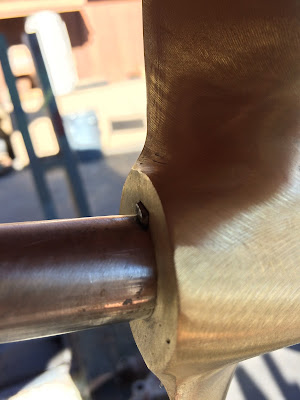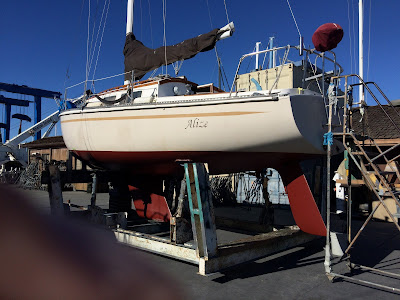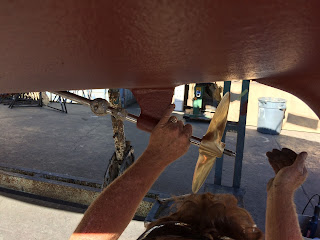I've neglected my propeller for many years.
I replaced my zinc anodes- but not as often as recommended. I probably put new zincs on every 6 months - but every 3 months would have been better.
Each time I've dove under my boat, I've seen more oxidation and more corrosion building up on my prop.
It was time to replace the propeller...
However - replacing the propeller was a separate process. A marine surveyor working out of the shipyard named Ken Closs helped me with the following propeller replacement.
Here's a step by step instructional on...
How to put a new propeller on a boat.
 |
| my three sons |
1. Decide when its time for a new propeller.
In the photo above, I have arranged my propellers in order of disintegration.
On the far left is the prop that has been pushing me through the water for the past decade. It is ready to retire. In the middle is my secondary (emergency) prop, it is not quite as oxidized, but the blades are bent from hitting a rock. On the far right, is my brand new propeller.
As you can see, these are all Michigan 2-blade sailor propellers. This is a popular brand for sailboats.
On my 30 foot Newport 30 from 1976, I use a 12 inch diameter, 11 inch pitch propeller. My shaft bore is 7/8 inch.
In the photo below, you can see that the corrosion on my old propeller has caused the edge of the blades to break off.
 |
| looks like a mouse chewed on my blades |
How do you know if your propeller had oxidized?
If you scratch your prop blade with sandpaper, and you see pinkish bronze under the surface rust - then it is time to replace your prop. If it's still good, you will see golden bronze upon scratching. |
| an old propeller, that has not yet oxidized fully |
In the photo above, you can see that my secondary propeller has not yet past the point of no return, in terms of oxidation. When I scratched it with a heavy grit sandpaper, I found fresh copper metal. There was no pinkish tone, therefore in regards to oxidation I am still good. However, this prop has already hit a rock - and so the blades are bent out and the bent region shows cracking. For this reason, it was not worth restoring.
Another way to assess a propeller's oxidation - is the ring tone. When you hit a good propeller with another metal object, there should be a resonating tone, like a bell.
If the prop is oxidized, then there will be a dull, brief tone - with no resonance.
2. Buy a new propeller
So - it was time for me to buy a new prop.
My brand new prop (below) set me back 550.00. I ordered it from Wilmington Propeller in Los Angeles. Other good west coast retail prop suppliers are: Tacoma Propeller in WA and Pacific Propeller in San Diego. Be prepared, if the retailers don't have what you need in stock, you will need to put in a order through Michigan Sailor. This could take 6-8 weeks. Plan this out before you haul your boat into the shipyard.
 |
| new prop, 2 nuts and a key |
3. Removing your old propeller
So, when you pull off your old propeller, first you will pull out the cotter pin at the end of your prop.
Just snap it in half, you'll put a new one on soon.
Then you should unscrew 2 nuts (1 large and 1 small). This may take some coaxing. Get a big wrench and tap it with a mallet.
Once the nuts are off - you can slide the propeller down the shaft.
There is also a special propeller puller tool that helps with this process.
Once the propeller is removed, you will see there is a slim metal object holding the prop against your shaft, this is called a propeller key.
You can see my 2 nuts and prop key in the photo above. Hold onto all these items, you need them once you put on your new propeller.
4. Once your prop is removed, clean up your shaft, nuts, prop key.
In the photo below you can see my propeller shaft all cleaned up. On the top of the threading area, you can see the groove that the propeller key slides into. There is a similar groove on the propeller. The prop key works like a joint to hold the propeller in place around the shaft. This prevents the prop from spinning independent of the shaft. At this point, make sure to clean up this groove and your prop key.
 |
| all cleaned up, ready for a new prop |
5. Fit the new propeller on the shaft with the propeller key
A good fitting propeller should land on your shaft with a satisfying thud. That means the bore diameter is a good, snug fit. Use a pen or a knife edge to mark the spot up on the shaft where the prop naturally slides up to. (prop shafts are tapered).
Now, pull off the prop, and put your prop key into the groove on the shaft. It should fit in easily. Then slide the prop on top, over the key. You want the propeller to slide into place at the same place it landed without the prop key. In this manner, it should still line up with the first mark you made.
This is how you make sure you have your propeller and propeller key at their ideal spot on your shaft.
 |
| lining up the prop with prop key |
In photo above - you can see the front (fore) of my propeller with the prop key snugged in on the shaft.
 |
| tightening the nuts |
6. Tighten the propeller nuts
Place your small nut on first. Hand tighten, then use a large wrench for tension. You can place a large wooden block between the prop blades and the hull of the boat - to keep the shaft from spinning as you tension the prop. Once the smaller nut is secure, tighten the second (larger) one on behind it. The larger nut takes more of the load. Tension it the same way.
It should be noted that schools of thought differ in regards to whether the thin nut should be placed on first or second. I have heard passionate and convincing opinions on both theories (thin nut first or thin nut second..). For more on this subject, you can read this article from Bolt Science.
 |
| put in a new cotter pin |
7. Insert the cotter pin
Get yourself a fresh cotter pin. There should be a cotter pin hole at the end your shaft. With pliers, bend out the pin around itself. This prevents the nuts from sliding off.
 |
| the finished product |
Now just trim the ends of the cotter pin and Voila - you are done.
Splash the boat back in the water and fire up the engine.
If you've done this correctly - your boat should move forward as you increase the throttle.
If it doesn't - haul it back out and try again....
Good luck and let me know if this was helpful in the comments section below...
Captain Curran -




